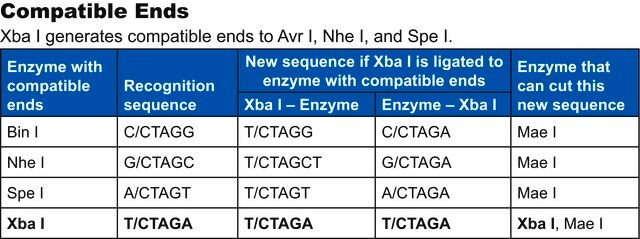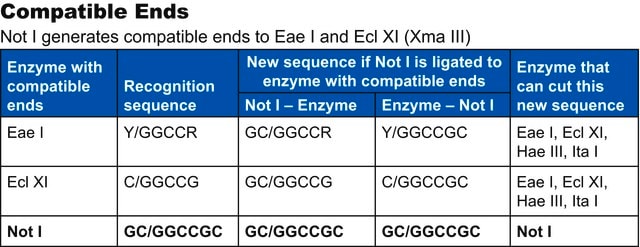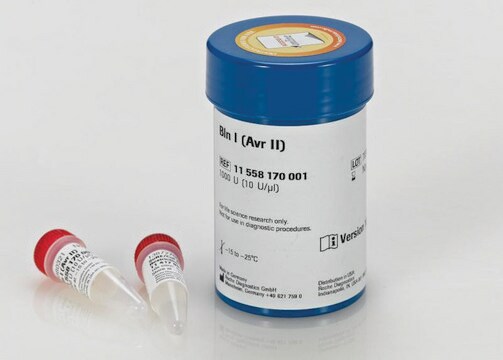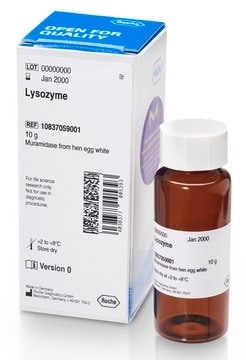SPEI-RO
Roche
Spe I
from Sphaerotilus species
Sinónimos:
Spe I, SPE I
About This Item
Productos recomendados
biological source
bacterial (Sphaerotilus spp.)
Quality Level
form
solution
specific activity
10000 U/mL
packaging
pkg of 1,000 U (11008951001 [10 U/μl])
pkg of 1,000 U (11207644001 [40 U/μl])
pkg of 200 U (11008943001 [10 U/μl])
manufacturer/tradename
Roche
parameter
37 °C optimum reaction temp.
color
colorless
pH
8.0 (39 °F)
solubility
water: miscible
suitability
suitable for molecular biology
application(s)
life science and biopharma
sample preparation
foreign activity
Endonucleases 10 units, none detected
shipped in
dry ice
storage temp.
−20°C
Categorías relacionadas
General description
Specificity
*A*CTAGT
Restriction site: *A↓*CTAGT
*A↓*CTAGT
Heat inactivation: Spe I can be heat inactivated by incubation at 65 °C for 15 minutes (up to 100 U/μg DNA).
Quality
1μg Ad2 DNA is incubated for 16 hours in 50μl SuRE/Cut Buffer H with an excess of Spe I. The number of enzyme units which do not change the enzyme-specific pattern is stated in the certificate of analysis.
Absence of exonuclease activity
Approximately 5μg [3H] labeled calf thymus DNA are incubated with 3μl Spe I for 4 hours at +37°C in a total volume of 100μl 50mM Tris-HCl, 10mM MgCl2, 1mM Dithioerythritol, pH approximately 7.5. Under these conditions, no release of radioactivity is detectable, as stated in the certificate of analysis.
DNA Profile
- λ: 0
- φX174: 0
- Ad2: 3
- M13mp7: 0
- pBR322: 0
- pBR328: 0
- pUC18: 0
- SV40: 0
Unit Definition
Storage and Stability
Analysis Note
Spe I ends are compatible with ends generated by Bln I, Nhe I, and Xba I.
Isoschizomers
The enzyme is an isoschizomer of Bcu I and Ahl I.
Methylation sensitivity
As indicated by (*) on the recognition sequence above, Spe I is inhibited by the presence of N6-methyladenine and 5′-methylcytosine ( mA↓m CTAGT).
Incubation temperature
+37°C
PFGE tested
Spe I has been tested in Pulsed-Field Gel Electrophoresis (on bacterial chromosomes). For cleavage of genomic DNA (E. coli C 600) embedded in agarose for PFGE analysis, we recommend using 10U of enzyme/μg DNA and 4 hour incubation time.
Ligation and recutting assay
Spe I fragments obtained by complete digestion of 1μg Ad2 DNA are ligated with 1U T4 DNA Ligase in a volume of 10μl by incubation for 16 hours at +4°C in 66mM Tris-HCl, 5mM MgCl2, 5mM Dithiothreitol, 1mM ATP, pH 7.5 (at +20°C), resulting in >90% recovery of Ad2 DNA.
Subsequent re-cutting with Spe I yields >95% of the typical pattern of Ad2 × Spe I fragments.
The buffer in bold is recommended for optimal activity
- A: 75-100%
- B: 75-100%
- H: 100%
- L: 75-100%
- M: 100%
Other Notes
Solo componentes del kit
- Enzyme Solution
- SuRE/Cut Buffer H 10x concentrated
Storage Class
12 - Non Combustible Liquids
wgk_germany
WGK 1
flash_point_f
does not flash
flash_point_c
does not flash
Certificados de análisis (COA)
Busque Certificados de análisis (COA) introduciendo el número de lote del producto. Los números de lote se encuentran en la etiqueta del producto después de las palabras «Lot» o «Batch»
¿Ya tiene este producto?
Encuentre la documentación para los productos que ha comprado recientemente en la Biblioteca de documentos.
Artículos
The term “Restriction enzyme” originated from the studies of Enterobacteria phage λ (lambda phage) in the laboratories of Werner Arber and Matthew Meselson.
Contenido relacionado
Restriction endonucleases popularly referred to as restriction enzymes, are ubiquitously present in prokaryotes. The function of restriction endonucleases is mainly protection against foreign genetic material especially against bacteriophage DNA.
Nuestro equipo de científicos tiene experiencia en todas las áreas de investigación: Ciencias de la vida, Ciencia de los materiales, Síntesis química, Cromatografía, Analítica y muchas otras.
Póngase en contacto con el Servicio técnico






